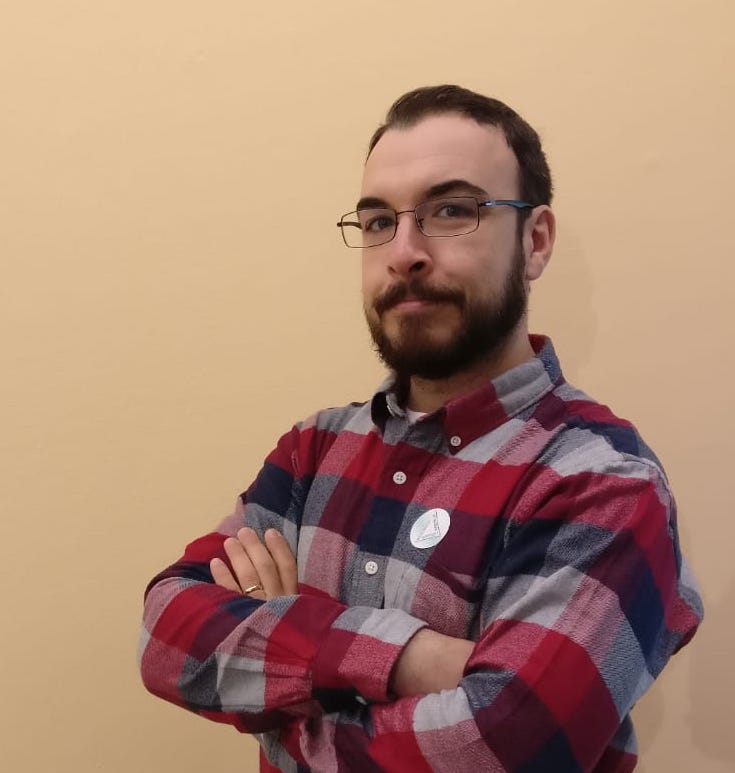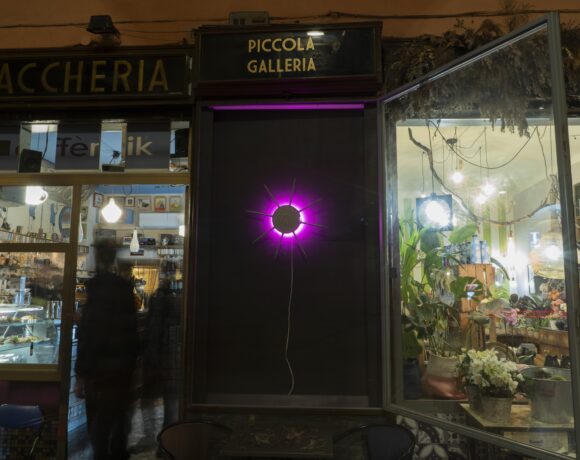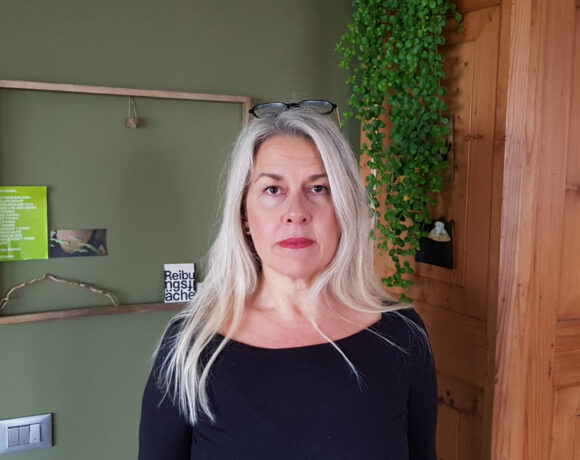Luca Massimo Barbero is Luca Massimo Barbero. Who knows him knows that he is an institutional figure and at the same time charismatic and very thick. Luca Massimo Barbero, for his career, would be an excellent subject to be treated at school given how much he still has to give for the cultural sector.
Francesco Liggieri: I wanted to make people understand who he is, but I didn’t want to summarize him, I would like you to describe yourself with the title of a work of art.
Luca Massimo Barbero: The Child’s Brain, by Giorgio De Chirico.

Luca Massimo Barbero, photo credits: Fredrik Nilsen Studio
Is there an exhibition or a project that you would like to realize but have not yet realized?
There is an exhibition that has been alive for some time, in the sense that it is enriched every day thanks to what I have studied, but above all thanks to many things that paradoxically I am finding on Instagram, and it is an exhibition in black. For some time I have been collecting a series of images, of sensations, of works that I find during my studies, in travels, on the street, on the walls and also on Instagram. They are images that take into account or that are built from a black, dark, umbratile imagination, not understood as nocturnal but as an existential cosmos, space of the mystery of the unknown. A sort of contemporaneization as in Marguerite Yourcenar’s The Black Opera, which does not start from the usual “new black” but includes the delirious Gothic universe, the space of the writers of the nineteenth century, the dreamer soul of the goyesche visions, by Odilon Redon, Fernand Khnopff, the drawings by Georges Seurat and also the Goth spirit of the eighties, up to contemporary works. A counter-light. For me light is important, it acts on the sight and the soul, to have a sense of finesse, the incisiveness of light, however, you must also know and live the shadow and darkness. An exhibition that takes into account all the imagination of black, not intended as “nocturnal”, but as the thought up to the most obvious, most obvious things.

@lucamassimobarbero, “When George and Virgil are in metaphysical dialogue. Off-White-Virgil Abloh”
What can a museum or a contemporary art foundation do for the growth of the country?
Every place where people confront and live art is a living space, useful to society in a way that is not summarized in an economic or managerial way, neither talking about costs nor revenues. The museum is not the preservation of ashes but the “vital custody of fire” as we say here in Fondazione Cini. It is an active place, which must dialogue with people and, conversely, with the needs that art feels in the new contemporary society. It is important that it is not entertainment, infotainment, but a place of knowledge, of curiosity, that gives refreshment to the soul, to the eyes and, at the same time, provokes questions, interest, questions about the human being, to ask questions about the future and the extraordinary vitality of history. Art is not a chronicle but a cultural agitator, a denunciation, a anticipatory content. It is a practice that urges and does not accommodate or justify. An exhibition space, whatever its nature, must be a “trap of temptations” where you do not recognize the things you know but are prompted by a new way of looking, to imagine following the extraordinary paths of art in its contemporaneity as in its past history. I call them “Inciampi” these moments in which you change look living a work, seeing it in a new way. Tripping makes you change your pace, lower and look up again, more surprised and more active. For this reason I believe that so-called museum operators should not be conservatives or guides or custodians but subtle “agitators of thought and of the way of seeing”. Many young people have this ability, this freedom. And then, curiously, the history of art open to new eyes, makes ideas change and can be economically functional. But beware: the pace of competition with media and advertising is short. There are two factions: the first is the current one that is not respected, which is that of those who believe that a museum is an operating place also economically, and this is permissible. But then we see that there is no attention to museums from that point of view. The other is much more interesting: what a museum really must be is a trap of temptation or what I call, precisely, a “stumbling block”, a place that must make sure that those who enter find a work, a word, a person, a cultural agitator that makes at least one person a day, a young person a day has a different idea of that place. I think you can change society by tripping up a person to make them look different.
.

@lucamassimobarbero-FAI – Negozio Olivetti-Venezia
What is your relationship with social networks?
I don’t use them. I have a great relationship but I would say almost exclusively with Instagram for the moment, because I think it has aroused some curiosity, but I do not use it to explain or to make small lessons. I use it because it’s a polymorphic, fluid place to share my imagination. I’m an inveterate postcard writer. I still send postcards and at the bottom at this moment my account, that is my @lucamassimobarbero, is a correspondence. Posts or stories are postcards that I often send to the authors of the images I post, which in the end are the “impossible postcards of Barbero”. I also use them with a minimum communication purpose of the activities that take place in Foundation or museums. Needless to say, the social networks of large museums, collections or other serial image hoarders are really a very useful point to get informed, not to think you have seen an exhibition or received a deepening, but a point from which to deepen.

@lucamassimobarbero, “Those Italian floors!”
Should the public be trained or be entertained in an art exhibition?
The public must be welcomed with a story that takes place in the space of the exhibition, the museum, step by step, leaving it free to make associations, providing them also. I would not say that it should be guided but that information should be suggested to it leaving traces of what the curator knows and, above all, wants to share, without imposing anything. When you see something deep, light, beautiful, unknown or you conceive it in a new way, the desire is to share it, make it accessible, then accompany the visitor in the unveiling, in the discovery of what maybe he thought he already knew.An exhibition is not entertainment intended in a current way, for that there are parties, events that “make you tear your head off thoughts”, those are wonderful pastimes. The exhibitions fall into that strange category which are the interests, the search for an elsewhere, the desire to see other worlds without having to move, travel to other dimensions simply by opening your mind and eyes. To do this, art asks to know a minimum, to appreciate it: art is not an immediate language, as we believe now, but it is certain that art has always spoken a universal language and, above all, a plurigenerational one. The comparison with the original is often surprising, necessary, art is lived with your body, with all your senses. After all, entertainment today is wonderfully present in technological devices, in mobile phones that, let’s face it, are a little our mirror, our source of gratification. Moving the mirror that is in front of us and not simply “look” but “see” is an action that art allows you to do and I always remain bewitched when I talk to young people, who know this extraordinary game. It is also for this reason that for some years I have been dedicating the exhibitions I am curating and setting up to young people, because it is the “looks of today” that always reveal and teach me new things. Our visual horizon and our mirror will soon be our metaverse, that is, our mobile phone. I use it a lot, we all use it and so it’s this new form of mirror. My exhibition L’occhio in gioco. Percezione, impressioni e illusioni nell’arte in progress at the Palazzo del Monte di Pietà in Padua ends with a series of mirrors just because it shows how the devices are now our mirror. The exhibition is likely to be a set of concepts that I tell as if it were a preconceived art, that is, “I look at what I recognize or that resembles something I know”. An exhibition will never be an entertainment, otherwise it becomes Disneyland.

@lucamassimobarbero-That New York Lucio Fontana installation Feeling! @hauserwirth
Is there a place in your memory that you identify as the beginning of your journey and work?
I grew up in a house full of books and dogs. I chose the books (the two don’t really work that way). The place could be the image of me cutting out a white-and-white image of a sculpture, on the back I write some invented phrases, I place it on a shelf with a rudimentary system and shoot a polaroid with a stolen camera in the house. Join the image to the word, to the other story and share it. Perhaps this is why I had an atypical training, first as author, then photographer and commentator of art, crazy for music and anthropology brisk. Each of these parts can be found in my exhibitions and, I hope, in my texts and publications. I realized that my path was image and writing. Paradoxically, I understood this starting from books, and I united this thing in the idea of building a path, a story.

@lucamassimobarbero, “Azadi Tower”
Is there, in your opinion, something interesting in the so-called blockbuster exhibitions?
Numbers are important, sometimes fundamental, but not the starting point for an exhibition. One exhibition is successful if it has many visitors and another is successful if it is worth deepening and lives by word of mouth of people surprised and amazed by a discovery. To me, in sincerity, there are only well-thought-out and well-made exhibitions and exhibitions that are not at all, apart from the often-used names and even exhibitions with the shoelaces of the great Keith Haring. In New York I had the good fortune to visit two unforgettable blockbuster exhibitions: MoMA with Pollock and Whitney with Rothko. They were blockbusters not because they make many visitors but because they compared two large giants. If instead the aforementioned exhibitions have names that in some way are always the same, from Caravaggio to the impressionists to poor Basquiat, then no, I do not think they are interesting.
If you weren’t the director of the Giorgio Cini Foundation’s Institute of Art History in Venice, what would you like to do?
This. I have always liked to build paths through images, art history, photography, beyond the work in institutions. My friends say I should actually have been an architectural historian… they lie. Others say that I would have done exhibitions of shells and palm leaves even if I had been a castaway on a deserted island.

@lucamassimobarbero-Hauser&Wirth-NY
If you could choose a historical or fantasy character to be included in your work team who would you choose?
What was the name of the radiant replicant of Blade Runner with the make up spray? (ndr: refers to Pris, the android played by Daryl Hannah). But I have a rather perverse historical passion, I would choose the nineteenth-century politician Pietro Paleocapa, “de’ modern plumbers prince” you know? But maybe I would prefer the singer Siouxsie (ndr: of Siouxsie and the Banshees) when young, the immense. Her Spellbound piece has enchanted, bewitched, enchanted me!
Legend has it that you only organize your exhibitions after seeing the impact of natural light in the exhibition space. Is that true? How does your attention to light come about?
It’s true, I also observe how darkness fills the spaces, because sometimes there is no natural light. They say that I score spaces, probably as if it were a punctuation, that is, as if it were a story to be written, a film to be edited. Perhaps this attention comes from the idea that, as Manlio Brusatin said, shadow is more important than light, to really reveal the body of images.

@lucamassimobarbero, “That Post Opening Feeling! Thank You to you ALL for coming!”
Will Venice survive?
Venice will always survive. Venice as an idea of an imaginary place. It may not survive here, if we continue to treat it like this. He will live together with man the image of the city. Venice, I always say, has a great fortune: it has many doors distributed all over the world, because the image of the lagoon city will survive even in its myth. Myth, of course, which is a betrayed, handed down story, which is storytelling. Instead, it is the world, it is this world that we must preserve, we must think of delivering it in its best condition, from the climate, to society and to the love for art and for the other.
Info:
Luca Massimo Barbero chose to accompany this interview with images taken from his Instagram profile: @lucamassimobarbero

Independent artist and curator. Founder of No Title Gallery in 2011. I observe, study, ask questions, take informations and live in contemporary art, a real stimulus for my research.






NO COMMENT